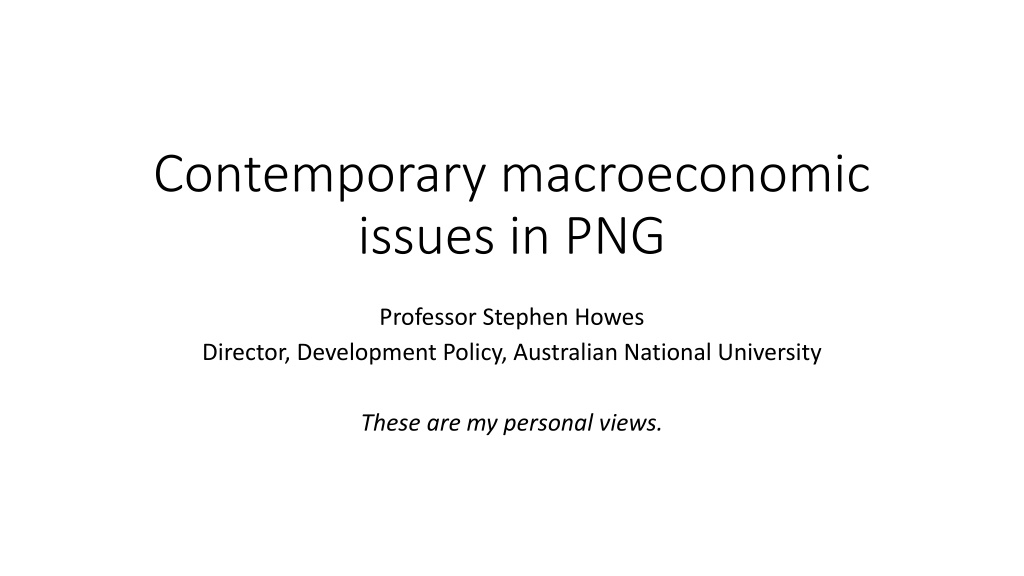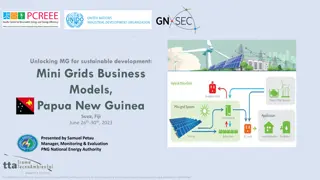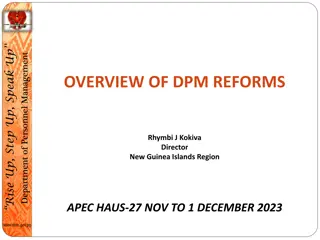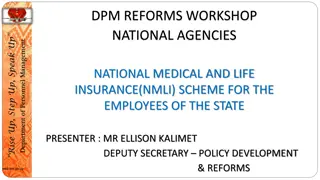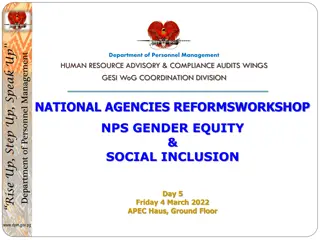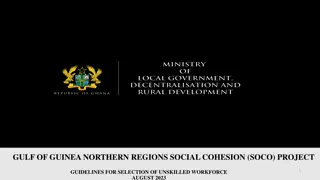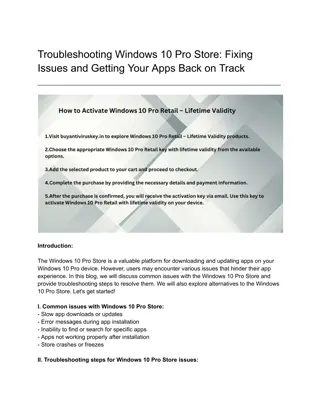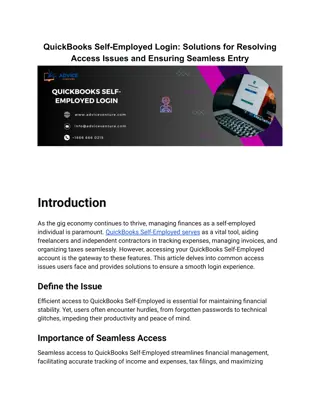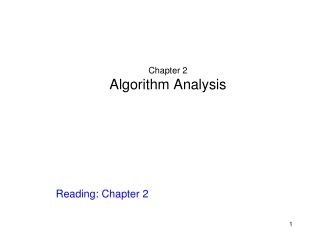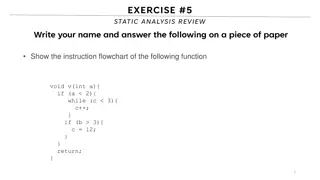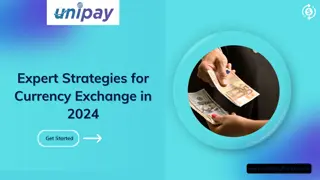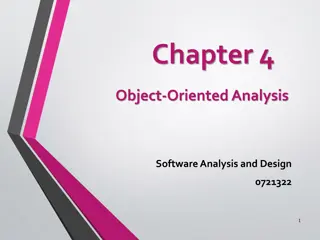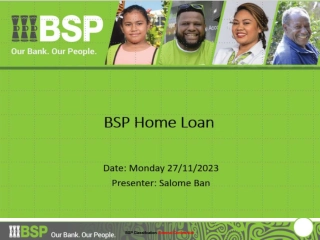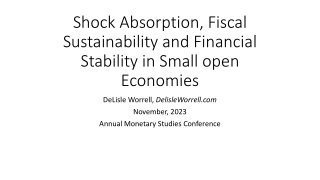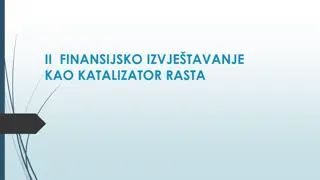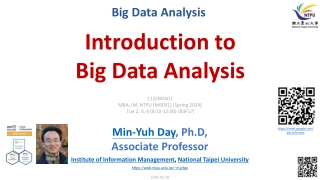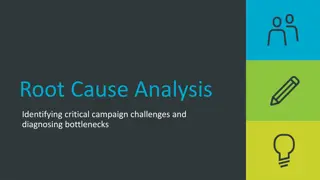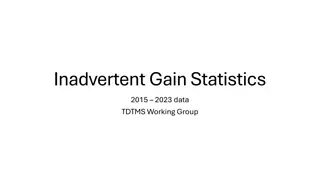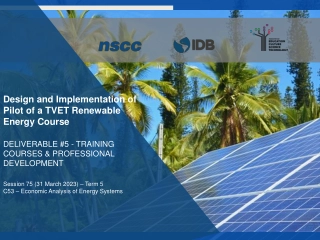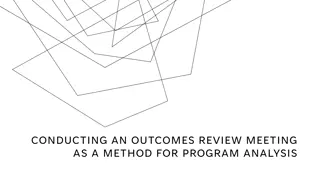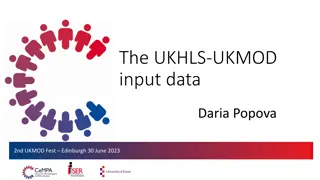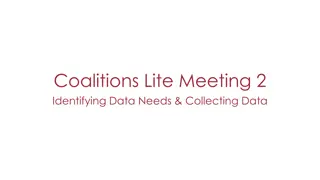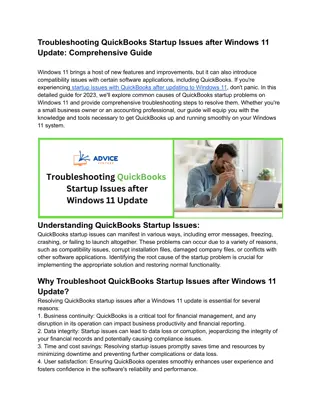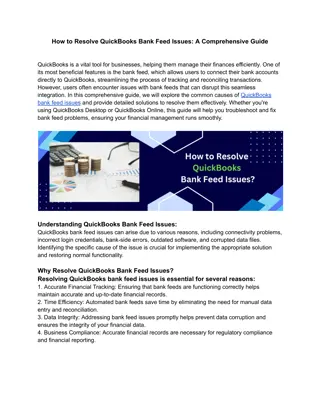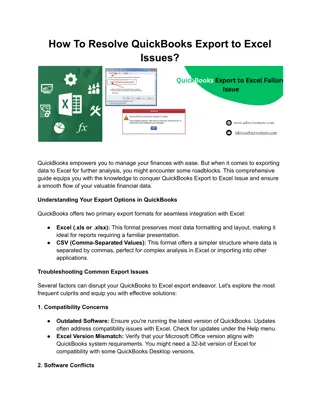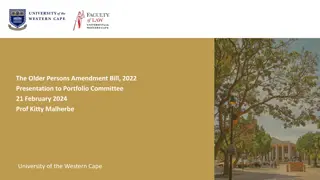Analysis of Contemporary Macroeconomic Issues in Papua New Guinea
Professor Stephen Howes, Director of Development Policy at Australian National University, presents his personal views on macroeconomic issues in Papua New Guinea. The focus is on the exchange rate regime and its management, excess liquidity, and fiscal policy. Various economic indicators point to challenges such as stability in the exchange rate, stagnant imports, and fluctuations in foreign reserves.
Analysis of Contemporary Macroeconomic Issues in Papua New Guinea
PowerPoint presentation about 'Analysis of Contemporary Macroeconomic Issues in Papua New Guinea'. This presentation describes the topic on Professor Stephen Howes, Director of Development Policy at Australian National University, presents his personal views on macroeconomic issues in Papua New Guinea. The focus is on the exchange rate regime and its management, excess liquidity, and fiscal policy. Various economic indicators point to challenges such as stability in the exchange rate, stagnant imports, and fluctuations in foreign reserves.. Download this presentation absolutely free.
Presentation Transcript
Contemporary macroeconomic issues in PNG Professor Stephen Howes Director, Development Policy, Australian National University These are my personal views.
Approach This is a very controversial subject, where opinions differ greatly, especially re the exchange rate. I separate out analysis from recommendations.
Structure 1. 2. Introduction Exchange rate regime (XRR) the main focus Why focus on the XRR? Who is responsible for the XRR? What is the XRR? How is the XRR managed? Why is the XRR the way it is? What is the problem? What is the solution? What does the IMF agreement say? What is the outlook for reform? 3. Excess liquidity 4. Fiscal policy 5. Conclusion
(a) The most important issue for business Business Advantage CEO ratings of concerns (5 point scale); rating on top of column 1 4.4 1 2 4.2 1 3 3 1 1 2 4.0 3 1 3 2 3 4 3.8 3 4 4 3.6 6 3 3.4 3.2 3.0 2014 2015 2016 2017 2018 2019 2020 2021 2022 2023 Foreign exchange Security
(b) A number of economic indicators point to a serious problem/big changes (i) Real exchange rate at the same level as the end of the boom
(ii) Nominal exchange rate has become much more stable over time against the USD (Kina appreciated 17% on a trade-weighted nominal basis from end-2021 to Sep 2022 (BPNG stats))
(iv) FX reserves were falling but now at historic highs Foreign reserves in USD million (LHS) and as months of imports (RHS) 4500 12 4000 10 3500 3000 8 2500 6 2000 1500 4 1000 2 500 0 0 Total reserves (USD million) Total reserves in months of imports
(BPNG explanation that high level of reserves necessary for debt service payments not convincing) External debt service payments as % of reserves 50% 45% 40% 35% 30% 25% 20% 15% 10% 5% 0% 1989 1990 1991 1992 1993 1994 1995 1996 1997 1998 1999 2000 2001 2002 2003 2004 2005 2006 2007 2008 2009 2010 2011 2012 2013 2014 2015 2016 2017 2018 2019 2020 2021 2022
(c) XR regime often misunderstood To make PNG exports competitive in international markets, a flexible exchange rate regime was adopted in 1995, and the Kina was floated. The Kina value is now determined by demand and supply in the foreign exchange market. PNG National Gold Bullion Policy 2023
(d) Not much discussed relative to its importance Exchange rate policy is a very contentious issue and is the only monetary policy tool which transmits to the market. Kina Bank submission to Phase One Review. BPNG six-month Monetary Policy Statements generally focus on Kina Facility Rate rather than on the XR regime.
Who is responsible for the XR regime, and subject to what constraints?
Before 2000 XR regime a responsibility of the Executive Government, subject to international agreements The par value of the monetary unit shall be determined by the Head of State, acting on advice, given after consultation with the Central Bank and in accordance with any international agreement to which Papua New Guinea is a party Section 45(1), Central Banking Act (Chapter 138) PNG entered into an agreement with the IMF in 1975 to make the kina convertible on the current account (Article VIII) Article VIII2(a) of the IMF requires that no member shall, without the approval of the Fund, impose restrictions on the making of payments and transfers for current international transactions.
After 2000 XR regime a responsibility of BPNG, without reference to international agreements The official value of the monetary unit in terms of other currencies may be determined by the Board [formerly Governor] acting on, and in accordance with, policy statements issued pursuant to Section 11 and to achieve the objects of the Central Bank under this Act. Section 58 (1), Central Banking Act 2000 (as amended in 2021)
Up to 2014 Convertible on the current account The bedrock of macroeconomic policy in PNG Far outlived the hard kina policy If exchange rate management is to be judged purely from the standpoint of currency convertibility, Papua New Guinea would have to be awarded relatively high marks, despite the blemish of the 1994 currency crisis. Sugden and King (1997) Pegged to 1994, then floating.
From 2014 Kina non-convertible on the current account (BPNG, IMF) IMF first raised the issue of excess demand for FX in 2014. Every year since 2016, IMF has found PNG to maintain exchange restrictions in violation of Article VIII, Section 2(a). A non-convertible currency cannot be floating as supply and demand are not equated. A non-convertible currency must be an overvalued one. BPNG has run five different FX regimes from 2014 June 2014 to September 2016: crawl-like regime June 2016 to August 2017: stabilised regime September 2017 to November 2020: crawl-like regime November 2020 to April 2023: stabilised regime April 2023 to current: crawl-like regime
Instruments to manage the exchange rate 1. FX allocation by BPNG No obligation to meet all demand. FX not distributed on the basis of price/willingness to pay, but as a fraction of orders (administrative allocation) BPNG never asks buyers to bid for its FX nor acts as a price setter 2. Market price determined by the interbank price Since the introduction of trading bands in June 2014 The result: Authorised dealers have no incentive to pay more for $ BPNG never requires that dealers pay more for $ The Kina is increasingly stuck, and determined by guidance rather than market forces.
The PGK is increasingly stuck Number of changes per year in the USD/PGK interbank rate, 2008 to 2023
Rationale BPNG has never given an explicit defence of rationing or its XR management The biggest macro-policy change since independence. But it has made public its aversion to depreciation on the grounds that it will be inflationary [A] large depreciation will increase the import prices and domestic inflation, which would adversely affect people s welfare (Sep 2021 MPS) Depreciation is limited by Rationing Making the Kina sticky . BPNG behaviour was consistent with BPNG s price stability mandate. In other words, problem not with BPNG but with its mandate. This is why the IAG recommended that BPNG have a dual mandate So that it take into account the damaging growth consequences of rationing and an overvalued currency.
Change in BPNG mandate S7. OBJECTIVES OF THE CENTRAL BANK OLD: (a) to formulate and implement monetary policy with a view to achieving and maintaining price stability CBA 2000 7(a) NEW: (a) to formulate and implement monetary policy with a view to achieving and maintaining price stability and promoting employment and economic growth, especially of the non-mineral non-petroleum sector CBA 2000 7(a) post 2021 amendment. IMPLICATION FOR XR: From S57 to S11 to s7: S57: Value of Kina in terms of other currencies set by the Bank in accordance with policy statements issued pursuant to Section 11 Section 11: The Board shall at least twice a year issue a policy statement setting out the monetary policy of the Central Bank to achieve and maintain its objectives as defined in Section 7(a) for the following six month period.
FX rationing (non-convertibility) Is something very few countries do. Is something PNG used not to do. Harms imports needed for growth Harms exports e.g. fish canneries closing Harms competition Banks don t want new customers Why does Puma face such little competition? Harms PNG s reputation Why would foreign investors want to invest in PNG, if they can t repatriate their profits? Encourages fiscal profligacy on the part of government Encourages illegal behaviour (black market) on the part of the private sector
An overvalued exchange rate Is good for urban consumers But hurts farmers (the biggest employment category) Agriculture did well in the 1990s Hurts import substitution: one of the government s biggest policy goals Makes payment of foreign debt easier Can result in either an FX/BoP crisis or FX rationing.
Reforms needed Commit to current account convertibility BPNG through its Montary Policy Statements Government through legislation Convertibility will require a mix of greater FX releases and depreciation. To unstick the kina, introduce a price signal into the allocation of FX by BPNG Either by an auction: consistent with a floating regime Or by BPNG becoming a price setter when it releases FX into the market: shifting to a crawling peg.
Other ideas Blame/change resource agreements (PDAs) Forcing companies to convert $ to Kina will increase the supply of $, but also the demand for $ Strengthening compliance BPNG is both cracking down on non-compliance and giving companies an incentive not to comply. If there is less rationing, there will be more compliance. Enforcing compliance needs to be balanced against the growth objective Dread of depreciation? Depreciation will increase prices but does not have to be a return to the chaos of the 1990s Depreciation does not mean floating; it can be managed. Wait for the boom PNG has been waiting for the last decade for the boom The problem needs to be fixed before the next boom, or it will be repeated
IMF program In 2023, under the IMF lending program ($US918 m), the PNG Government agreed that A sequenced roadmap for reforming exchange rate operations and regulations will be adopted to make the exchange rate more flexible in the medium-term to support Kina convertibility. Road map due August 2023 Positive agreement, but agreement with IMF also commits to revoking BPNG s dual mandate and priority again given to combatting inflation. If no growth mandate, why would BPNG agree to XRR reform?
XRR reform outlook Downside Prospect of long-term damage due to loss of confidence in Kina. Problem may not be addressed before the next boom, and then forgotten about. Lack of political support: even the Trade Minister doesn t support a depreciation. Upside BPNG Chair s APNGBC speech (May 2021) BPNG is well aware of the issues faced by business in accessing foreign exchange. In order to cushion PNG from these shocks it has been necessary for the BPNG to maintain our currency at a certain value. BPNG s most recent MPS (March 2023): the Bank will help address the imbalance in the FX market and enhance exchange rate flexibility Recent depreciation Mixed IMF program
Excess liquidity and what to do about it PNG has long had a problem of excess liquidity with commercial bank deposits at BPNG about double the 10% required minimum. As a result, policy lending rate (KFR) ineffectual. Every now and then BPNG sells Central Bank Bills (CBBs) to mop up excess liquidity, but no serious, sustained effort. IMF and GoPNG (BPNG) have agreed to introduce a fixed rate tender full allotment system, again by August This would offer unlimited amounts of CBBs to banks at the Kina Facility Rate (KFR)
Excess liquidity has been a feature of the PNG economy since the late 1990s
Problems with the full allotment proposal Most excess liquidity is with the two foreign banks, and they have limits on how many T Bills/CBBs they can buy. KFR too high at 3.5%. Cf 364-day T-Bills at 3.05% Remunerating bank deposits will crowd out private lending. A subsidy to the private sector Financial implications for BPNG. Untested instrument outside of Europe. Alternatives (all very difficult) Increase the CRR. Reduce government deposits in commercial banks Increase bank lending
Fiscal reform Government has committed to eliminate the deficit by 2027. This is also part of the IMF program. The government s fiscal correction path is built on strict expenditure restraint and strong revenue growth.
Budget forecasts show strong revenue growth and expenditure restraint
Conclusion The government faces a number of difficult macroeconomic challenges. A return to current account convertibility (an end to FX rationing) is the key growth-promoting and fiscal-disciplining reform the government can take. Either government could legislate this, or BPNG could commit to it.
Tenkyu tru! Devpolicy Blog PNG Economic Database PNG Budget Database
